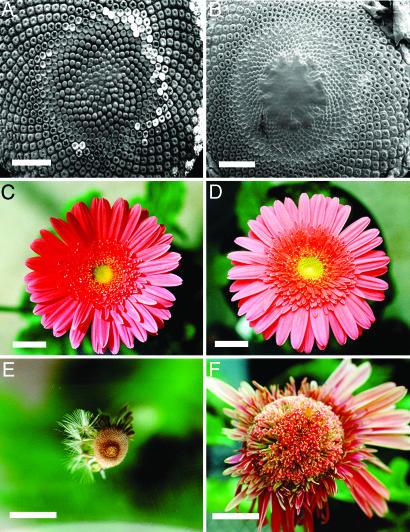Fig. 6.
Indeterminate growth of the inflorescence meristem in transgenic Gerbera. Development of wild-type (A, C, and E) and antisense GRCD2 (B, D, and F) inflorescence over time. The number of flower primordia is fixed at an early stage of development in wild-type Gerbera (A), whereas in the transgenic plants, the inflorescence meristem continues to proliferate (B). C and D show inflorescences at full flowering. At 35 days later, the wild-type inflorescence has matured and shed its seeds (E), whereas the transgenic inflorescences continue to produce flowers (F). The wild-type capitulum produces >600 florets (593 ± 56, n = 13), but the strong antisense GRCD2 lines produce up to 1,200 flowers (976 ± 98, n = 13). Transgenic plants in which GAGA2 was down-regulated (14) and that showed indeterminate flower meristems produced 594 ± 76 flowers (n = 6). The indeterminate growth mode of the anti-GRCD2 inflorescences was reflected both by continuously increasing production of disk flowers and by a concomitant enlargement of the receptacle. Although superficially unorganized, the spiral phyllotaxis of the transgenic inflorescences of the transgenic lines was not disturbed in terms of numbers of parastichies. [Scale bars indicate 1 mm (A and B) and 2 cm (C–F).]

